Wake Region Estimates of Artificial Reefs in Vietnam: Effects of Tropical Seawater Temperatures and Seasonal Water Flow Variation
Abstract
1. Introduction
2. Materials and Methods
2.1. Target ARs and Environmental Conditions
2.2. Numerical Method
2.3. Flow Domains and Boundary Conditions
2.4. Wake Region
2.5. Efficiency Index
3. Results and Discussion
3.1. Wake Volume with the Change of Seawater Temperature
3.2. Flow Characteristics of ARs and AR Sets
4. Conclusions
Author Contributions
Funding
Conflicts of Interest
References
- Perkol-Finkel, S.; Shashar, N.; Benayahu, Y. Can artificial reefs mimic natural reef communities? The roles of structural features and age. Mar. Environ. Res. 2006, 61, 121–135. [Google Scholar] [CrossRef] [PubMed]
- Dupont, J.M. Artificial reefs as restoration tools: A case study on the west Florida shelf. Coast. Manag. 2008, 36, 495–507. [Google Scholar] [CrossRef]
- Lee, M.O.; Otake, S.; Kim, J.K. Transition of artificial reefs (ARs) research and its prospects. Ocean. Coast. Manag 2018, 154, 55–65. [Google Scholar] [CrossRef]
- Paxton, A.B.; Peterson, C.H.; Taylor, J.C.; Adler, A.M.; Pickering, E.A.; Silliman, B.R. Artificial reefs facilitate tropic fish at their range edge. Commun. Biol. 2019, 2, 168. [Google Scholar] [CrossRef]
- London Convention and Protocol/UNEP. London Convention and Protocol/UNEP Guidelines for the Placement of Artificial Reefs; London Convention and Protocol/UNEP: London, UK, 2009; pp. 1–21. [Google Scholar]
- Claudet, J.; Pelletier, D. Marine protected areas and artificial reefs: A review of the interaction between management and scientific studies. Aquat. Living Resour. 2004, 17, 129–138. [Google Scholar] [CrossRef]
- Kim, D.; Woo, J.; Yoon, H.S.; Na, W.B. Efficiency, tranquility and stability indices to evaluate performance in the artificial reef wake region. Ocean. Eng. 2016, 122, 253–261. [Google Scholar] [CrossRef]
- Lök, A.; Metin, C.; Ulaş, A.; Düzbastılar, F.O.; Tokaç, A. Artificial reefs in Turkey. ICES J. Mar. Sci. 2002, 59, S192–S195. [Google Scholar] [CrossRef][Green Version]
- Choi, C.G.; Takeuchi, Y.; Terawaki, T.; Serisawa, Y.; Ohno, M.; Sohn, C.H. Ecology of seaweed beds on two different types of artificial reef. J. Appl. Phycol. 2002, 14, 343–349. [Google Scholar] [CrossRef]
- Choi, C.G.; Ohno, M.; Sohn, C.H. Algal succession on different substrate covering the artificial iron reef at Ikata in Shikoku, Japan. ALGAE 2006, 21, 305–310. [Google Scholar] [CrossRef]
- Jensen, A.; Collins, K.; Lockwood, P. Current issues relating to artificial reefs in European seas. In Artificial Reefs in European Seas; Jensen, A.C., Collins, K.J., Lockwood, A.P.M., Eds.; Kluwer Academics Publishers: Dordrecht, The Netherlands, 2000; pp. 489–499. ISBN 07-7923-5845-7. [Google Scholar]
- Jensen, A. Artificial reefs of Europe: Perspective and future. ICES J. Mar. Sci. 2002, 59, S3–S13. [Google Scholar] [CrossRef]
- Pendleton, L.H. Creating Underwater Value: The Economic Value of Artificial Reefs for Recreational Diving; The San Diego Oceans Foundation: San Diego, CA, USA, 2004; pp. 1–11. [Google Scholar]
- Düzbastılar, F.O.; Lök, A.; Ulaş, A.; Metin, C. Recent developments on artificial reef applications. in Turkey Hydraulic experiments. Bull. Mar. Sci. 2006, 78, 195–202. [Google Scholar]
- López, I.; Tinoco, H.; Aragonés, L.; García-Barba, J. The multifunctional artificial reef and its role in the defence of Mediterranean coast. Sci. Total Environ. 2016, 550, 910–923. [Google Scholar] [CrossRef] [PubMed]
- Jakšić, S.; Stamenković, I.; Đorđević, J. Impacts of artificial reefs and diving tourism. TURIZAM 2013, 17, 155–165. [Google Scholar] [CrossRef]
- Sheng, Y.P. Physical characteristics and engineering at reef sites. In Artificial Reef Evaluation with Application to Natural Marine Habitats; Seaman, W., Ed.; CRC Press: Boca Raton, FL, USA, 2000; pp. 51–94. ISBN 978-0849390616. [Google Scholar]
- Lee, I.C.; Kim, D.; Jung, S.; Na, W.B. Prediction of primary physical measures for cost-effective management of artificial seaweed reefs. Mar. Technol. Soc. J. 2020, 54, 25–43. [Google Scholar] [CrossRef]
- Kim, D.; Woo, J.; Na, W.B.; Yoon, H.S. Flow and structural response characteristics of a box-type artificial reef. J. Korean Soc. Coast. Ocean. Eng. 2014, 26, 113–119. [Google Scholar] [CrossRef]
- Woo, J.; Kim, D.; Yoon, H.S.; Na, W.B. Efficient placement models of labyrinth-type artificial concrete reefs according to wake volume estimation to support natural submerged aquatic vegetation. Bull. Mar. Sci. 2018, 94, 1259–1272. [Google Scholar] [CrossRef]
- Kim, D.; Jung, S.; Kim, J.; Na, W.B. Efficiency and unit propagation indices to characterize wake volumes of marine forest artificial reefs established by flatly distributed placement models. Ocean. Eng. 2019, 175, 138–148. [Google Scholar] [CrossRef]
- Na, W.B. Artificial reefs and their issues and scientific basis. Sci. Fish. Oceanogr. 2020, 2, 77–82. [Google Scholar]
- Kim, D.; Woo, J.; Na, W.B. Intensively stacked placement models of artificial reef sets characterized by wake and upwelling regions. Mar. Technol. Soc. J. 2017, 51, 60–70. [Google Scholar] [CrossRef]
- Yanagi, T.; Nakajima, M. Change of oceanic condition by the man-made structure for upwelling. Mar. Pollut. Bull. 1991, 23, 131–135. [Google Scholar] [CrossRef]
- Kim, D.S.; Shimasaki, Y. Change in marine environment after artificial reef deployment in the south sea of Korea. J. Fac. Agric., Kyushu Univ. 2013, 58, 403–415. [Google Scholar]
- Dao, M.S.; Pham, T. Management of coastal fisheries in Viet Nam. In Assessment, Management and Future Directions for Coastal Fisheries in Asian Countries; Silvestre, G., Garces, L., Stobutzki, I., Ahmed, M., Valmonte-Santos, R.A., Luna, C., Lachica-Alino, L., Munro, P., Christensen, V., Pauly, D., Eds.; WorldFish Center Conference Proceedings: Penang, Malaysia, 2003; Volume 67, pp. 957–986. [Google Scholar]
- Trinh, T.H. The Current Coral Reefs, Marine Species in Binh Dinh Province; Nha Trang Oceanographic Institute: Nha Trang, Vietnam, 2002. [Google Scholar]
- Trinh, T.H. The Topographic and the Current Coral Reefs in Binh Dinh Province; Nha Trang Oceanographic Institute: Nha Trang, Vietnam, 2003. [Google Scholar]
- Trinh, T.H. Model Building Restoration and Management of Coral Reef Ecosystem in Qunag Nam Province; Nha Trang Oceanographic Institute: Nha Trang, Vietnam, 2006. [Google Scholar]
- Do, V.K. Additional Research Scientific Basis for Management of Cat Ba and Co To Islands; Hai Phong Research Institute of Marine Fisheries: Hai Phong, Vietnam, 2005. [Google Scholar]
- Nguyen, T.L. Research in Building Artificial Reef in Ninh Thuan to Protect., Regenerate and Develop Fisheries Resources; Science and Technology Report; Institute for Marine Science and Fishing Technology, Nha Trang University: Nha Trang, Vietnam, 2014. [Google Scholar]
- Le, T.N.Q. Wake Region Estimation of Vietnam’s Artificial Reefs Considering Tropical Seawater Characteristics. Master Thesis, Pukyong National University, Busan, Korea, 2016. [Google Scholar]
- Ha, T.H.; Dinh, V.U.; Nguyen, T.V. Circulation of coastal Nha Trang Bay. Sci. Technol. 2013, 29, 65–71. [Google Scholar]
- Kim, D.; Woo, J.; Yoon, H.S.; Na, W.B. Wake lengths and structural responses of Korean general artificial reefs. Ocean. Eng. 2014, 92, 83–91. [Google Scholar] [CrossRef]
- Woo, J.; Kim, D.; Yoon, H.S.; Na, W.B. Characterizing Korean general artificial reefs by drag coefficients. Ocean. Eng. 2014, 82, 105–114. [Google Scholar] [CrossRef]
- Kim, D.; Jung, S.; Na, W.B. Wake region estimation of artificial reefs using wake volume diagrams. J. Fish. Mar. Sci. Edu. 2016, 28, 1042–1056. [Google Scholar] [CrossRef][Green Version]
- Kim, D.; Jung, S.; Na, W.B. Efficiency index diagram for wake region evaluation of artificial reefs facilitated for marine forest creation. J. Adv. Res. Ocean. Eng. 2016, 2, 169–178. [Google Scholar] [CrossRef]
- Yoon, H.S.; Kim, D.; Na, W.B. Estimation of effective usable and burial volumes of artificial reefs and the prediction of cost-effective management. Ocean. Coast. Manag. 2016, 120, 135–147. [Google Scholar] [CrossRef]
- Langhamer, O. Artificial reef effect in relation to offshore renewable energy conversion: State of the art. Sci. World J. 2012, 386713, 1–8. [Google Scholar] [CrossRef]
- Nguyen, D.N.; Nguyen, D.C.; Dao, A.T. Coral degradation and ability of rehabilitation of coral reefs in Co To Archipelago, Quang Ninh province, Vietnam. Deep-Sea Res. II 2013, 96, 50–55. [Google Scholar] [CrossRef]
- Nguyen, T.L. Research in Building Artificial Reefs Model for Sustainable Exploitation and Renewable Resources in Quang Nam Coast; Science and Technology Report, Institute for Marine Science and Fishing Technology; Nha Trang University: Nha Trang, Vietnam, 2015. [Google Scholar]
- Jung, S.; Kim, D.; Na, W.B. Wake volume characteristics considering artificial reef canyon intervals constructed by flatly distributed artificial reef set. J. Ocean. Eng. Technol. 2016, 30, 169–176. [Google Scholar] [CrossRef]
- Rojana-Anawat, P.; Pradit, S.; Sukramongkol, N.; Siriraksophon, S. Temperature, salinity, dissolved oxygen and water masses of Vietnamese waters. In Proceedings of the Fourth Technical Seminar on Marine Fishery Resources Survey in the South China Sea, Area IV: Vietnamese Waters, Bangkok, Thailand, 18–20 September 2000; Secretariat, Southeast Asian Fisheries Development Center: Bangkok, Thailand, 2001; pp. 346–355. [Google Scholar]
- ITTC-Recommended Procedures. Testing and Extrapolation Methods, General Density and Viscosity of Water. Available online: https://ittc.info/media/2017/75-02-01-03.pdf (accessed on 1 February 2020).
- Marcondes, F.; Sepehrnoori, K. An element-based finite-volume method approach for heterogeneous and anisotropic compositional reservoir simulation. J. Pet. Sci. Eng. 2010, 73, 99–106. [Google Scholar] [CrossRef]
- Finnegan, W.; Goggins, J. Numerical simulation of linear water waves and wave-structure interaction. Ocean. Eng. 2012, 43, 23–31. [Google Scholar] [CrossRef]
- ANSYS Inc. ANSYS CFX; Release 12.1; ANSYS Inc.: Canonsburg, PA, USA, 2009. [Google Scholar]
- Mann, K.H.; Lazier, J.R. Dynamics of Marine Ecosystems: Biological-Physical Interactions in the Oceans; Blackwell Publishing: Malden, MA, USA, 2006; pp. 163–215. ISBN 978-1-405-11118-8. [Google Scholar]
- Sawaragi, T. Coastal Engineering–Waves, Beaches, Wave-Structure Interactions; Elsevier Science, B.V.: Amsterdam, The Netherlands, 1995; pp. 429–469. ISBN 0-444-82068-X. [Google Scholar]
- Liu, T.L.; Su, D.T. Numerical analysis of the influence of reef arrangements on artificial reef flow fields. Ocean. Eng. 2013, 74, 81–89. [Google Scholar] [CrossRef]
- Jiang, Z.; Liang, Z.; Zhu, L.; Liu, Y. Numerical simulation of effect of guide plate on flow field of artificial reef. Ocean. Eng. 2016, 116, 236–241. [Google Scholar] [CrossRef]
- Jiang, Z.; Liang, Z.; Zhu, L.; Guo, Z.; Tang, Y. Effect of hole diameter or rotary-shaped artificial reef on flow field. Ocean. Eng. 2020, 197, 106917. [Google Scholar] [CrossRef]
- Androulakis, D.N.; Dounas, C.G.; Banks, A.C.; Magoulas, A.N.; Margaris, D.P. An assessment of computational fluid dynamics as a tool to aid the design of the HCMR-artificial-reefsTM diving oasis in the underwater biotechnological park of Crete. Sustainability 2020, 12, 4847. [Google Scholar] [CrossRef]
- Lindquist, D.G.; Pietrafesa, L.J. Current vortices and fish aggregations: The current field and associated fishes around a tugboat wreck in Onslow Bay, North Carolina. Bull. Mar. Sci. 1989, 44, 533–544. [Google Scholar]
- Eklund, A.M. The Effects of Post-Settlement Predation and Resource Limitation on Reef Fish Assemblages. Ph.D. Thesis, University of Miami, Miami, FL, USA, 1996. [Google Scholar]
- Oh, T.G.; Otake, S.; Lee, M.O. Estimating the effective wake region (current shadow) of artificial reefs. In Artificial Reefs in Fisheries Management; Bortone, S.A., Brandini, F.P., Fabi, G., Otake, S., Eds.; CRC Press: Boca Raton, FL, USA, 2011; pp. 279–295. ISBN 978-1439820070. [Google Scholar]
- U.S. Fish and Wildlife Service. Habitat Evaluation Procedures (HEP); ESM 102; USDI Fish and Wildlife Service, Division of Ecological Services: Washington, DC, USA, 1980.
- U.S. Fish and Wildlife Service. Standards for the Development of Habitat Suitability Index Models; ESM 103; USDI Fish and Wildlife Service, Division of Ecological Services: Washington, DC, USA, 1981.
- Moore, C.; Drazen, J.C.; Radford, B.T.; Kelley, C.; Newman, S.J. Improving essential fish habitat designation to support sustainable ecosystem-based fisheries management. Mar. Policy 2016, 69, 32–41. [Google Scholar] [CrossRef]
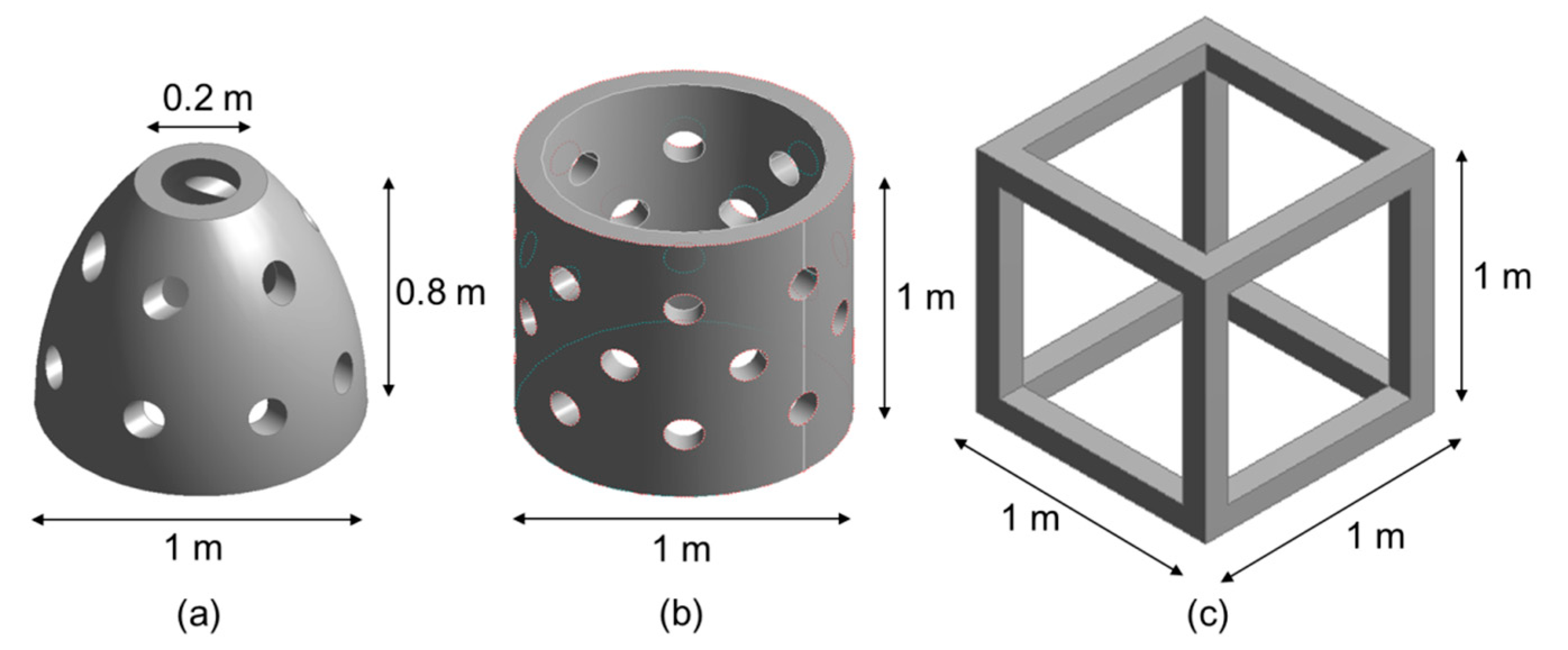
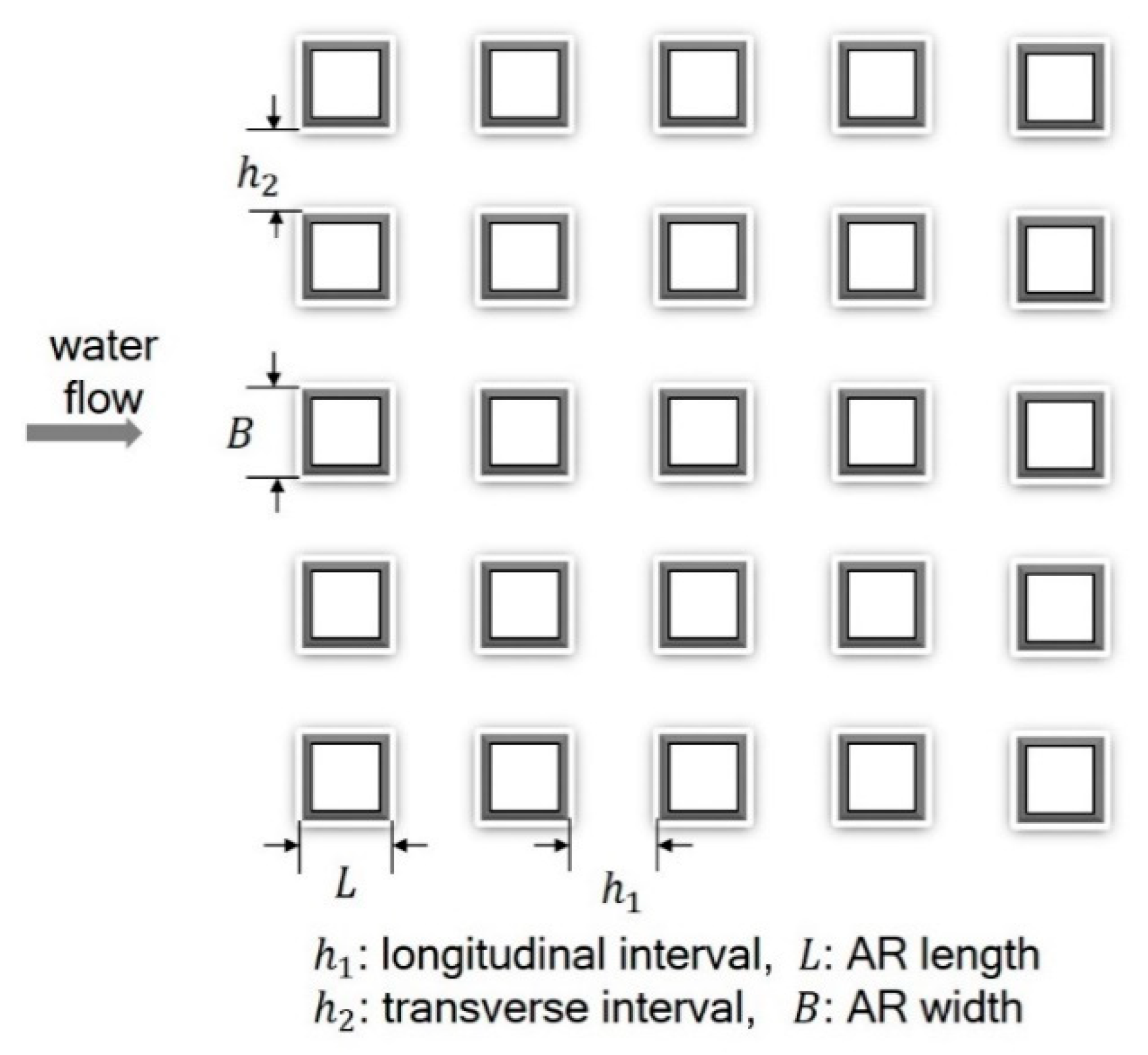
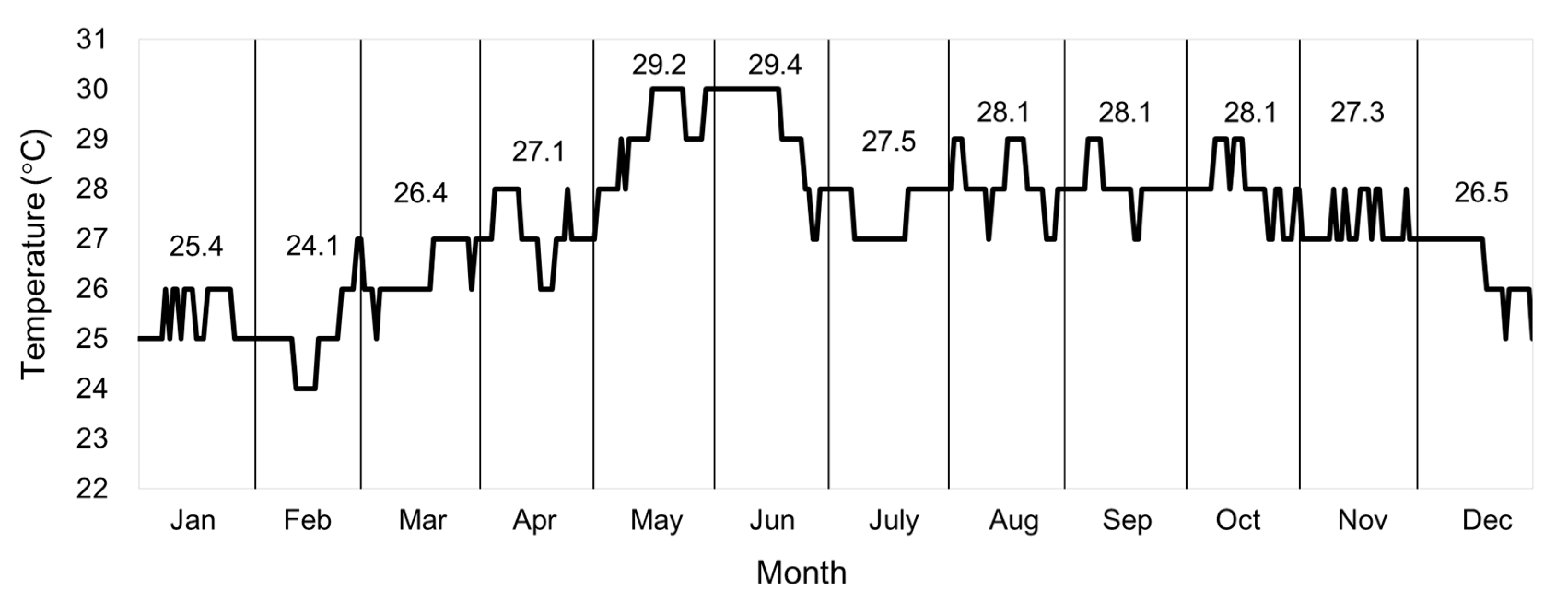
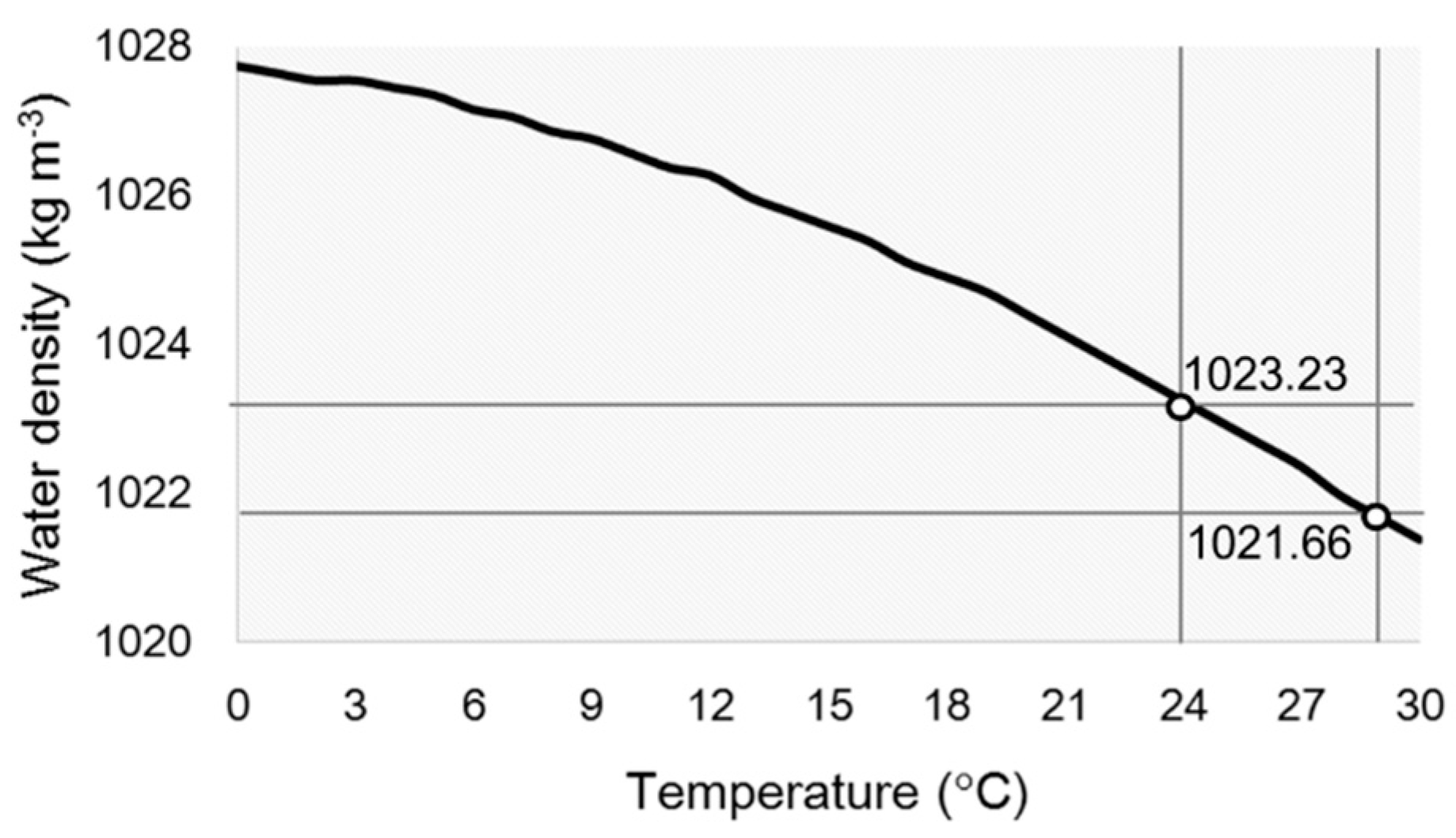
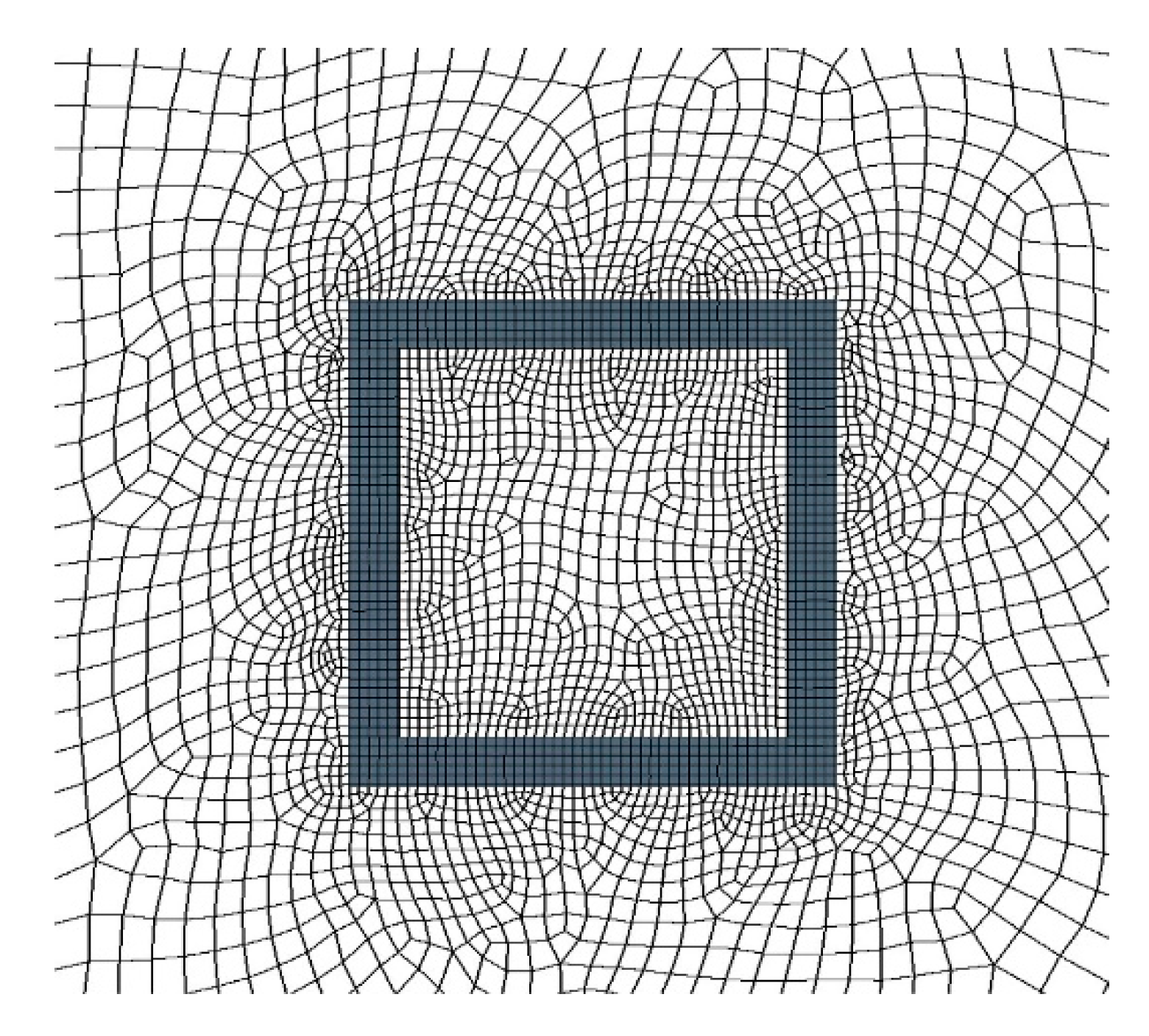
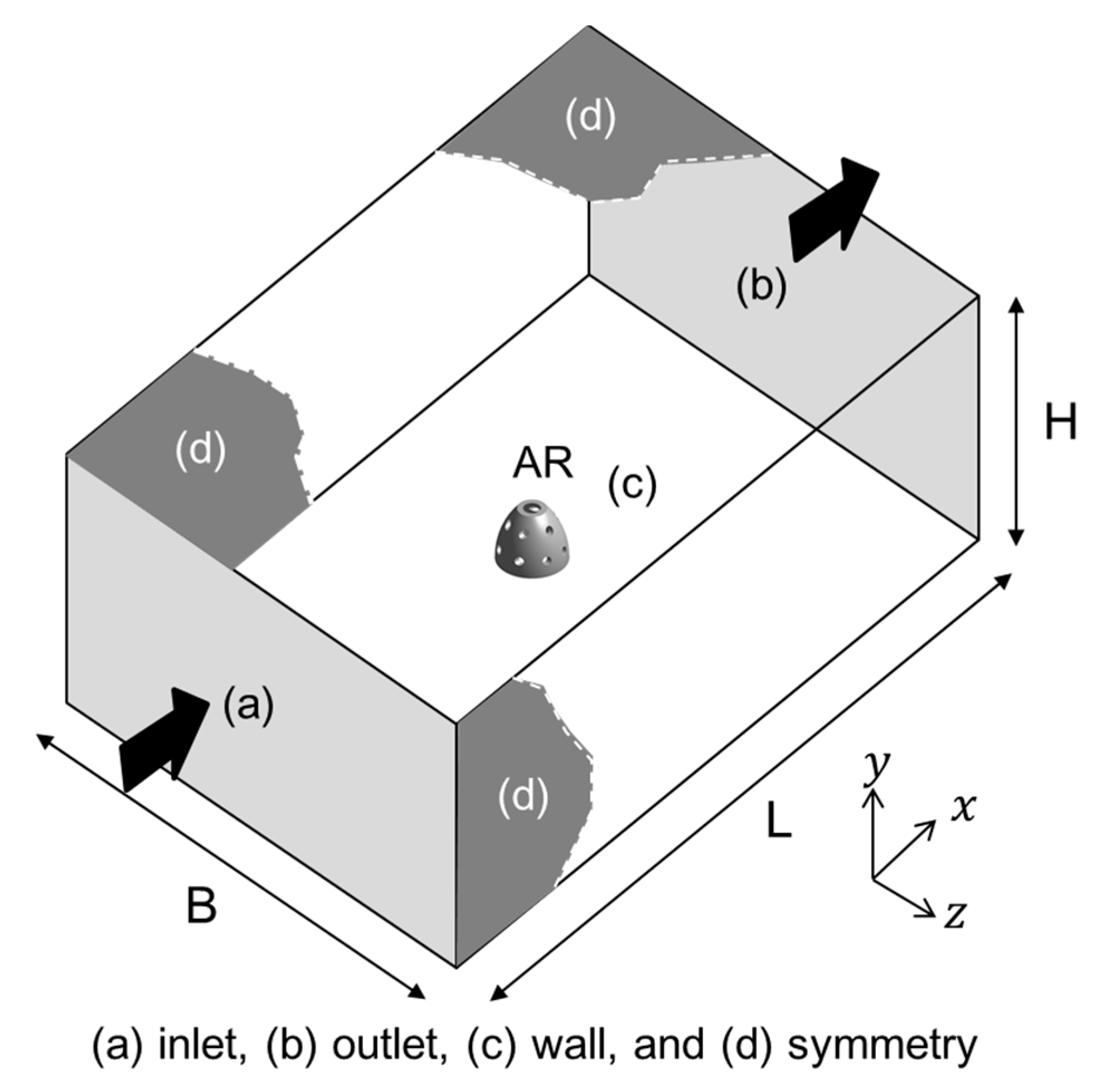
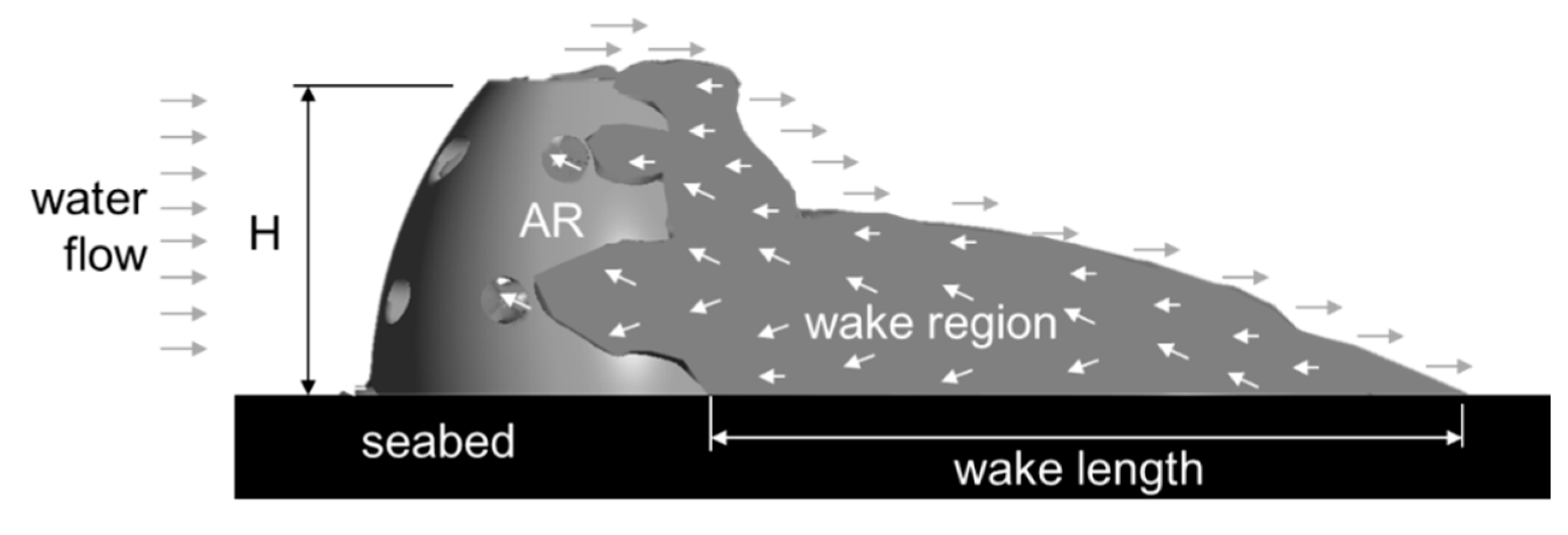

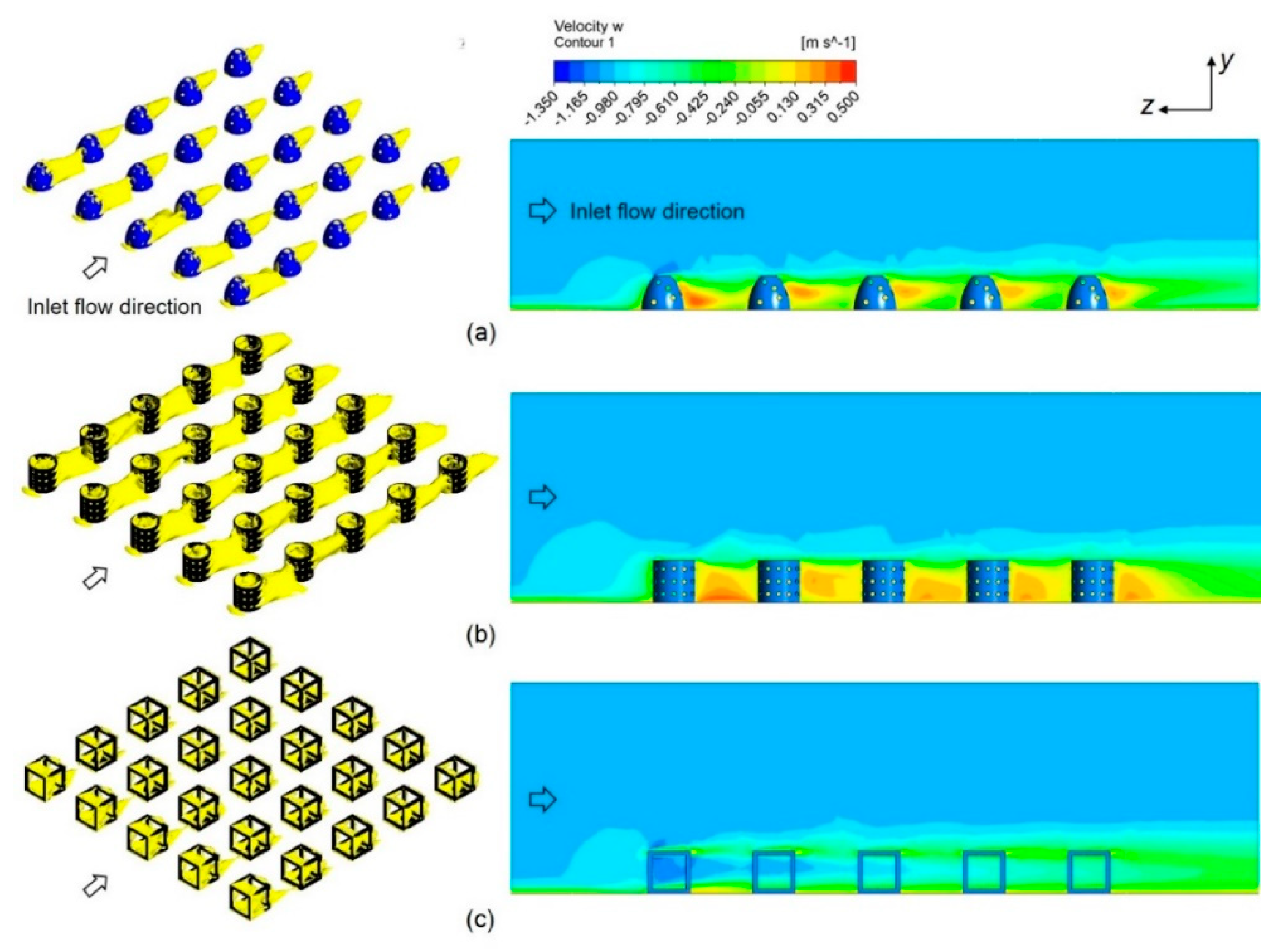
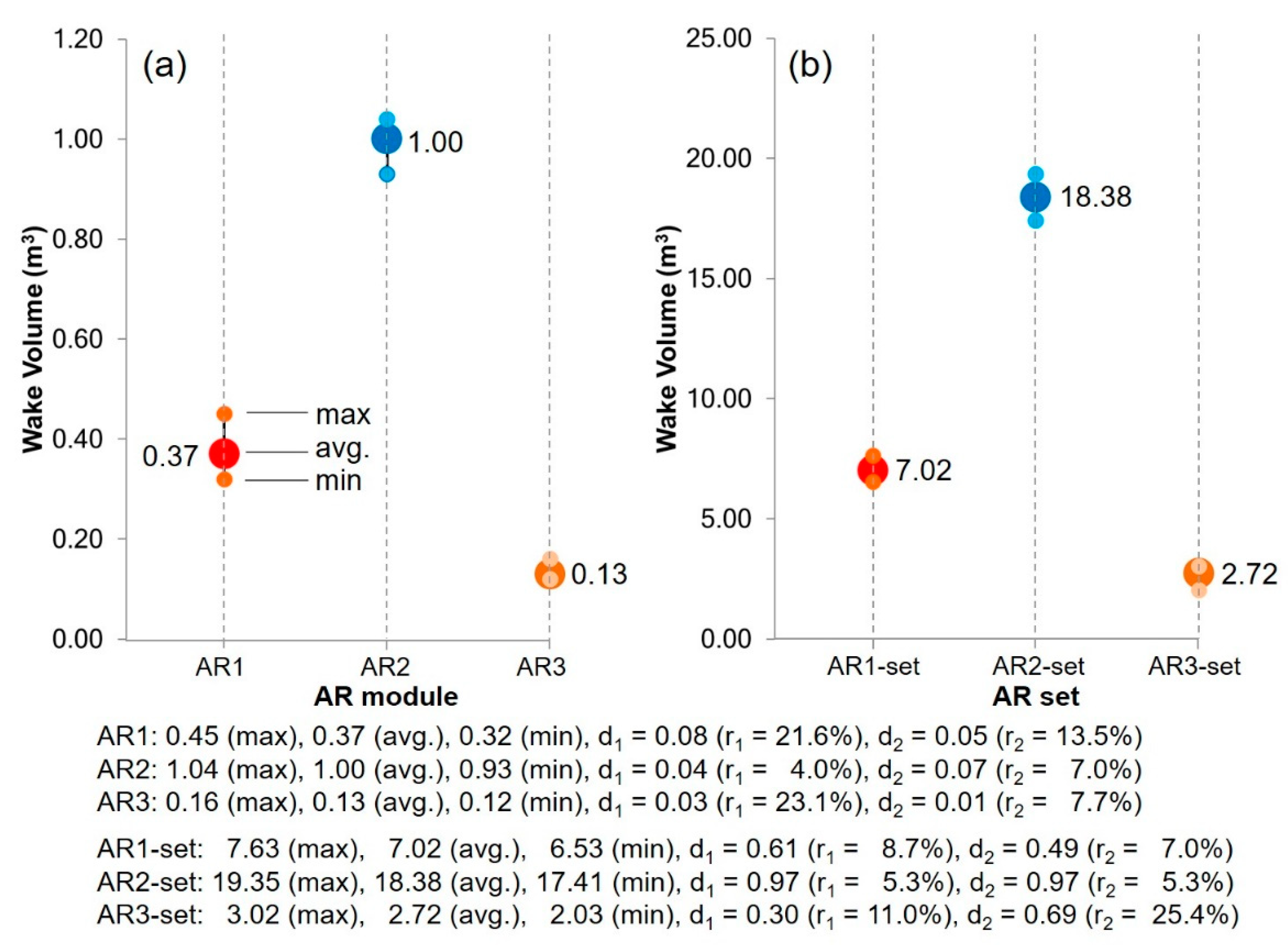

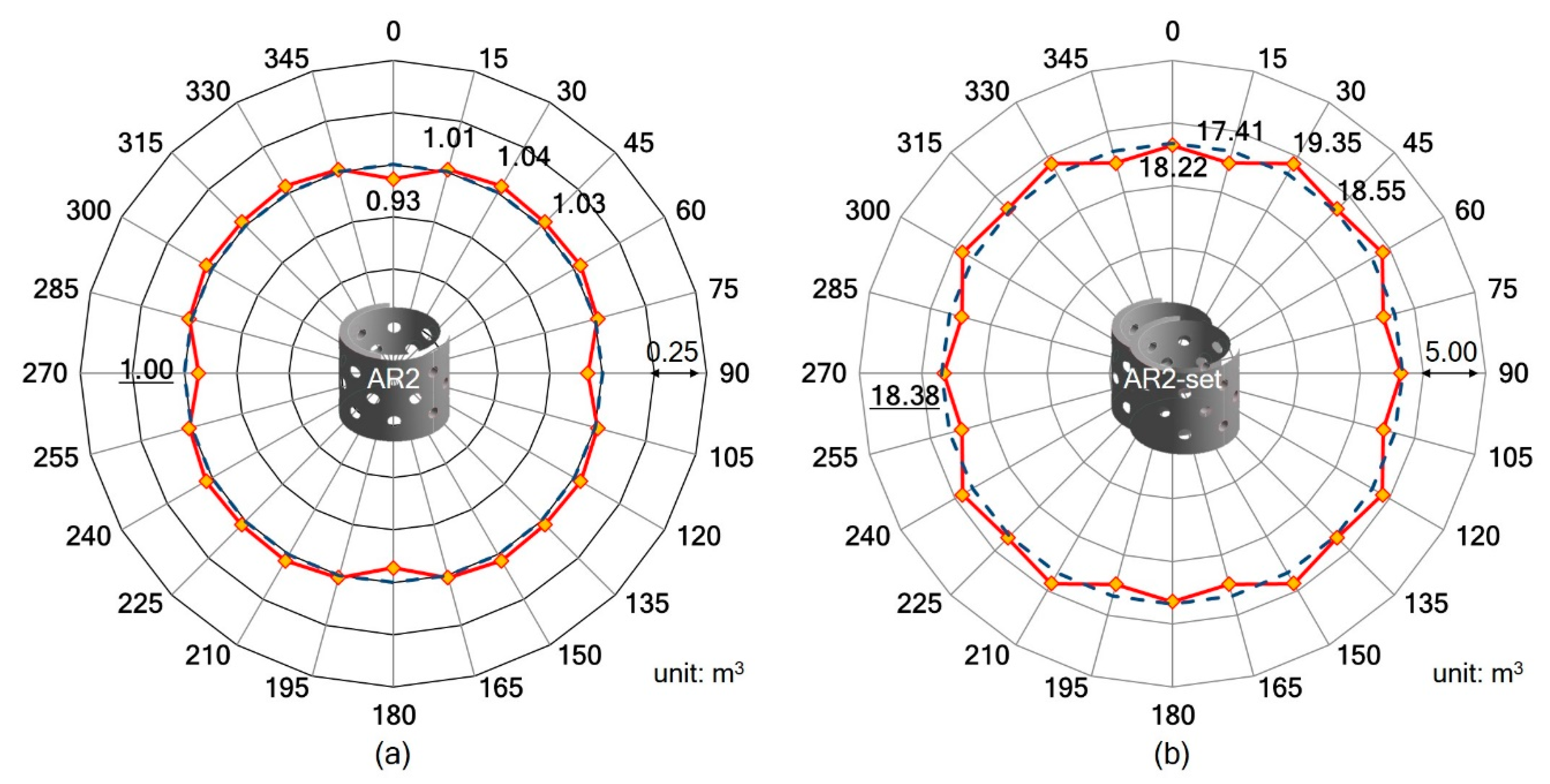

| AR1 | AR2 | AR3 | |
|---|---|---|---|
| Surface area (m2) | 4.332 | 6.148 | 4.080 |
| Volume (m3) | 0.133 | 0.108 | 0.104 |
| Seawater Temperature | Wake Volume (m3) | |||||
|---|---|---|---|---|---|---|
| AR Module | AR Set | |||||
| AR1 | AR2 | AR3 | AR1-Set | AR2-Set | AR3-Set | |
| 24 °C | 0.36 | 0.93 | 0.16 | 6.98 | 18.22 | 3.02 |
| 29 °C | 0.36 | 0.93 | 0.16 | 6.59 | 17.16 | 3.01 |
| Flow Directions and Average Wake Volume | Wake Volume (m3) | |||||
|---|---|---|---|---|---|---|
| AR Module | AR Set | |||||
| AR1 | AR2 | AR3 | AR1-Set | AR2-Set | AR3-Set | |
| 0° | 0.36 | 0.93 | 0.16 | 6.98 | 18.22 | 3.02 |
| 15° | 0.32 | 1.01 | 0.13 | 6.94 | 17.41 | 2.93 |
| 30° | 0.45 | 1.04 | 0.12 | 7.63 | 19.35 | 2.90 |
| 45° | 0.35 | 1.03 | 0.12 | 6.53 | 18.55 | 2.03 |
| Ave. | 0.37 | 1.00 | 0.13 | 7.02 | 18.38 | 2.72 |
| Flow Directions and Average Efficiency Index | Efficiency Index | |||||
|---|---|---|---|---|---|---|
| AR Module | AR Set | |||||
| AR1 | AR2 | AR3 | AR1-Set | AR2-Set | AR3-Set | |
| 0° | 2.71 | 8.61 | 1.54 | 2.10 | 6.75 | 1.16 |
| 15° | 2.41 | 9.35 | 1.25 | 2.09 | 6.45 | 1.13 |
| 30° | 3.38 | 9.63 | 1.15 | 2.29 | 7.17 | 1.12 |
| 45° | 2.63 | 9.54 | 1.15 | 1.96 | 6.87 | 0.78 |
| Ave. | 2.78 | 9.28 | 1.27 | 2.11 | 6.81 | 1.05 |
© 2020 by the authors. Licensee MDPI, Basel, Switzerland. This article is an open access article distributed under the terms and conditions of the Creative Commons Attribution (CC BY) license (http://creativecommons.org/licenses/by/4.0/).
Share and Cite
Le, Q.T.N.; Jung, S.; Na, W.-B. Wake Region Estimates of Artificial Reefs in Vietnam: Effects of Tropical Seawater Temperatures and Seasonal Water Flow Variation. Sustainability 2020, 12, 6191. https://doi.org/10.3390/su12156191
Le QTN, Jung S, Na W-B. Wake Region Estimates of Artificial Reefs in Vietnam: Effects of Tropical Seawater Temperatures and Seasonal Water Flow Variation. Sustainability. 2020; 12(15):6191. https://doi.org/10.3390/su12156191
Chicago/Turabian StyleLe, Quynh Thi Ngoc, Somi Jung, and Won-Bae Na. 2020. "Wake Region Estimates of Artificial Reefs in Vietnam: Effects of Tropical Seawater Temperatures and Seasonal Water Flow Variation" Sustainability 12, no. 15: 6191. https://doi.org/10.3390/su12156191
APA StyleLe, Q. T. N., Jung, S., & Na, W.-B. (2020). Wake Region Estimates of Artificial Reefs in Vietnam: Effects of Tropical Seawater Temperatures and Seasonal Water Flow Variation. Sustainability, 12(15), 6191. https://doi.org/10.3390/su12156191





